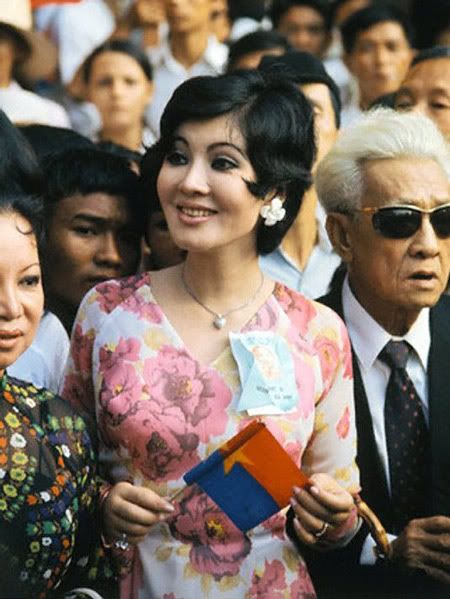Biết th́ thưa thốt, không biết th́ dựa cột mà nghe.
Ngoài ra đi t́m tin tức mà nhè đọc tin từ Việt nam cộng săn rồi đem lên Vietland post. Hài hước!
Ai nói Corbis vào Vietnam từ năm 2008? Tin từ Việtnam? Hahaha....
Ngoài ra. Theo như kinh nghiệm của tôi th́ bức ảnh này không phải ghép. OK?
Và đây là tài liệu cho những ai ba láp, bộp chộp, ba chớp ba nháng, không chịu suy nghĩ trước khi nói.
Corbis đă vào VN trước năm 1975 để có những tấm h́nh trong chiến tranh.
Đọc thêm 1 chút trích dẫn ở dưới đây đi để mở con mắt ghèn sáng hơn 1 chút, OK?:
Đọc chổ bôi đậm dùm.
".......ON THAT FIRST visit I had a secret test for Corbis. I wanted them to find an obscure photograph I’d taken in July 1966, when Frank Sinatra married Mia Farrow in Las Vegas. We were in Los Angeles and were given less than an hour’s notice to photograph the couple after the ceremony. Being Hollywood, I had some connections and called Clay Lacey, who sold Lear Jets. He got me to Las Vegas with minutes to spare. Sinatra hated the press, and we were allowed fewer than five minutes with the newlyweds as they just stood there, five yards away, taking no directions and answering no questions.
After photographing the couple, I shot a 300mm telephoto close-up of 98-pound Farrow’s tiny hand weighed down with Frank’s Lord-only-knows-how-many-carat diamond ring. Not a prize-winning photograph, but one that got UPI a lot of play and prompted AP to try to match the shot by cropping just the hand and ring out of their general view (enlarger to the ceiling and easel to the floor, resulting in a photograph with more grain than ring).
UPI’s old daily logs are the Rosetta stone to UPI’s files. The New York picture desk recorded every photograph transmitted on UPI’s wire by date, time, and number. Provided a date and sack number, a white-gloved researcher went into the FPF and, fewer than 10 minutes later, handed me the original file envelope.
In my cotton-gloved hands were the 35mm negatives that I’d touched last 38 years before! It was a wonderful, truly nifty moment.
FORMER UPI SAIGON picture bureau chief and photojournalist Bill Snead accompanied Dave and me on a second visit to Iron Mountain. Snead, who started at the Lawrence (KS) Journal-World in the photography department in 1954 while still in high school, rose up through newspapers in Topeka, KS, and Wilmington, DE, before running UPI’s photo operation in Vietnam and then later working at The Washington Post and National Geographic. He’s now back home in Kansas as the deputy editor of the Journal-World, in charge of the newsroom. He volunteered to scour the Vietnam files for us.
"
From the late 1950s to 1975 literally hundreds of journalists from all over the world poked their heads in at one time or another to check out the war, do a little dance with death, and pop out again," Snead says. "You could push fate as far as you wanted. Shooters who got the best pictures played it (Vietnam) like a rubber band, and sometimes it snapped." Five of UPI’s photographers didn’t return from Vietnam. Snead was soon surrounded by UPI photography logs and immersed in the Vietnam film and print collection.
"For the 40-some years that I shot film I had a well-earned reputation for not filing my negatives," says Snead. "My locker at The Washington Post, crammed with stained coils of 35mm negatives hanging on hooks, was known as ‘Snead’s Hanging Gardens of Kodak.’ But, when I worked in Vietnam (from 1967 to 1969) running the UPI photo bureau, I was pretty dependable at sending packets of captioned negatives to New York via air express after we’d transmitted the best pictures from Saigon. So 35 years later, while assembling a retrospective photography show, I wanted to see what happened to nearly two years worth of pictures that a lot of young men risked their lives to make with their choice to be combat photographers."
Snead says that after meeting Haynes and Milne at the Corbis Cave, Ann Hartman, manager of Library and Records Management for
Corbis, and her crew happily pulled files that matched his time spent working in Vietnam.
"I found a half dozen frames that I’d taken — but only one had my photo credit. Six pictures, out of hundreds. I looked in vain for Kent Potter’s incredible before-and-after sequence of a GI losing an arm to a rocket, for Kyochi Sawada’s
photographs of the Tet Offensive from Hue’s Citadel, where a very-alive Marine buried under rubble popped out from under a 50-caliber machine gun that was blasting away. Wearing my little white gloves, sorting through the old negatives, I felt sad that there weren’t more old memories to see and relieved when I’d see a frame that had put UPI on lots of front pages for a day."
Snead concluded, "It’s ironic that these historic images are deep underground — just like the majority of the shooters who made them.".............. ...................
Đọc hết ở đây:
http://www.nppa.org/news_and_events/...rbis_cave.html
____________________ ____________________ ____________________ _______
Và đây là vài tấm h́nh mà Bettmann/Corbis chụp vào những năm chiến tranh tại VN:





Trả lời dùm mấy tấm h́nh này chụp năm nào vậy ? Hahahahah
hey Nói Thẳng! Think twice before open your big mouth.




 Reply With Quote
Reply With Quote






Bookmarks